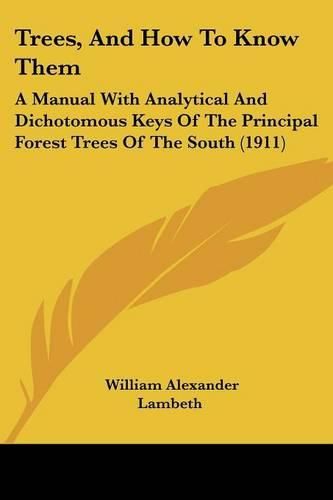Readings Newsletter
Become a Readings Member to make your shopping experience even easier.
Sign in or sign up for free!
You’re not far away from qualifying for FREE standard shipping within Australia
You’ve qualified for FREE standard shipping within Australia
The cart is loading…






Purchase of this book includes free trial access to www.million-books.com where you can read more than a million books for free. This is an OCR edition with typos. Excerpt from book: DICHOTOMOUS KEY How to Use the Key.?Standing before a tree with one of its leaves in hand, read the two statements at the beginning of each division; one of these statements will more completely describe the leaf than the other. At the end of the statement which harmonizes with the facts will be found a number. Further down this number will be found and it will be repeated at least twice. Then read the two statements under these numbers, selecting that statement which again most nearly agrees with the characteristics of both tree and leaf. Continue this process until a statement is followed by a name instead of a number; if no mistake has been made in the observations, that name will be the name of the tree. Suppose, for example, that standing in June before a tree we make the following observations: (1) That the tree has fruit with wings; (2) that since there are no leaves on last year’s growth of the twig, it is not evergreen but deciduous; (3) that the leaves are simple?only one blade; (4) that its veining is palmate, the large veins coming from near one point in the midrib; (5) that the leaves are attached opposite to each other on the stem., With these facts, commence by reading the two lines numbered 1 in the key; we find that our facts agree with the second line, because the fruit is not a cone. Line number 1 refers us to number 3. Turning to number 3 we again read the two lines and discover that as our specimen is not evergreen it must be under the second of the two lines, which refers us to number 9. As our leaf has only one blade, we are referred to 11, and in 11, since our leaf is palmately veined, we are referred to 23. Reading the first line, we find that it corresponds with our winged samara or fruit. Hence the tree is a maple. The student, after having …
$9.00 standard shipping within Australia
FREE standard shipping within Australia for orders over $100.00
Express & International shipping calculated at checkout
Purchase of this book includes free trial access to www.million-books.com where you can read more than a million books for free. This is an OCR edition with typos. Excerpt from book: DICHOTOMOUS KEY How to Use the Key.?Standing before a tree with one of its leaves in hand, read the two statements at the beginning of each division; one of these statements will more completely describe the leaf than the other. At the end of the statement which harmonizes with the facts will be found a number. Further down this number will be found and it will be repeated at least twice. Then read the two statements under these numbers, selecting that statement which again most nearly agrees with the characteristics of both tree and leaf. Continue this process until a statement is followed by a name instead of a number; if no mistake has been made in the observations, that name will be the name of the tree. Suppose, for example, that standing in June before a tree we make the following observations: (1) That the tree has fruit with wings; (2) that since there are no leaves on last year’s growth of the twig, it is not evergreen but deciduous; (3) that the leaves are simple?only one blade; (4) that its veining is palmate, the large veins coming from near one point in the midrib; (5) that the leaves are attached opposite to each other on the stem., With these facts, commence by reading the two lines numbered 1 in the key; we find that our facts agree with the second line, because the fruit is not a cone. Line number 1 refers us to number 3. Turning to number 3 we again read the two lines and discover that as our specimen is not evergreen it must be under the second of the two lines, which refers us to number 9. As our leaf has only one blade, we are referred to 11, and in 11, since our leaf is palmately veined, we are referred to 23. Reading the first line, we find that it corresponds with our winged samara or fruit. Hence the tree is a maple. The student, after having …